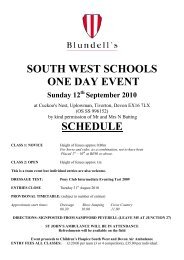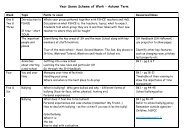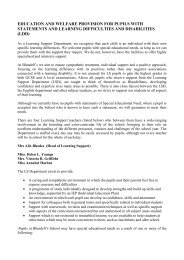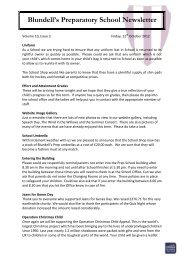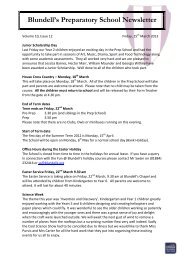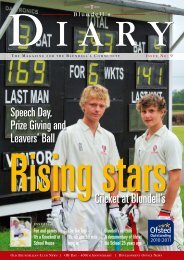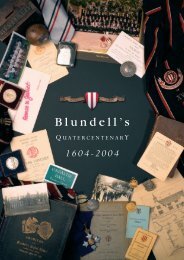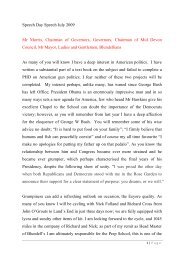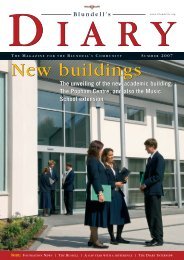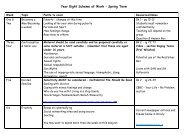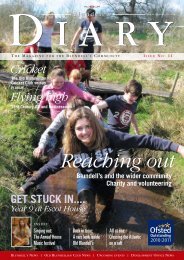Issue 7 Summer 2010 (6.3 MB) - Blundell's School
Issue 7 Summer 2010 (6.3 MB) - Blundell's School
Issue 7 Summer 2010 (6.3 MB) - Blundell's School
Create successful ePaper yourself
Turn your PDF publications into a flip-book with our unique Google optimized e-Paper software.
DUCKWORTH RELAYS<br />
The Duckworth Relay Races were first held on March 28th 1928, with the prize of a<br />
Challenge Cup presented by Mrs Hotblack and Capt. R.F.H. Duckworth, in memory of<br />
their father Robert Fagan Duckworth, an Old Blundellian. ‘Bob’ Duckworth, the son of a<br />
Blundell’s Master, attended the <strong>School</strong> from 1866 to 1876, and in each of his last two<br />
years he won the Masters Cup for the best overall performance at the Annual Sports<br />
Meeting held on the Green at Old Blundell’s. He obtained a Gilberd’s Exhibition to<br />
Magdalen College, Oxford, where he rowed for his College and played rugby for<br />
Somerset. After graduating with a BA in 1881, he succeeded his father as Headmaster<br />
of St. Peter’s <strong>School</strong>, Weston-super-Mare; a post he held until his death on October 9th<br />
1926.<br />
The Duckworth Relays were to be an inter-house competition, and the inaugural event<br />
comprised eight races, four in the ‘Open’ category and four in the ‘Under 16s’. The<br />
distances run were 4 x 110yds, 4 x 440yds, 4 x 1 mile, and a one mile medley race (with<br />
2 legs of 220yds, and one each of 440 and 880yds). The scoring was one point for first,<br />
two for second etc., the House with the lowest total of points being declared the<br />
winner. For this first competition Francis House were the victors and North Close<br />
runners-up.<br />
In the following year points scored in the Open races were doubled when calculating<br />
the total. There were several changes made for the competition in 1930. A third age<br />
category was introduced, so there were ‘Open’ races, and those for ‘Under 16½s’ and<br />
‘Under 15s’, with points in the ‘Open’ races trebled, and those in the ‘Under 16½s’<br />
doubled. The 4 x 1 mile contest was replaced by one of 4 x 880yds. North Close became<br />
the dominant team, winning 11 out of the 14 competitions between 1932 and 1945. In<br />
1962 Westlake teams won 8 out of the 11 races (there was no Junior 4 x 880yds in this<br />
year), and virtually monopolized the Cup throughout the 1960s and 1970s. The points<br />
system was altered in 1963, with 7 points awarded for a win, 6 points for second, and<br />
so on, with the House scoring the most points overall being declared the winner.<br />
Decimalization in the early 1970s meant that yards became metres.<br />
AYS<br />
The Duckworths had always been held towards the end of the spring term, and were<br />
often accompanied by cold rain, wind, sleet and on occasion snow. The decision was<br />
taken in 1982 to move the event to the week before half-term in the summer; there was<br />
to be no more snow, but avoiding the British rain was often impossible and occasionally<br />
the races had to be cancelled. The distances were also revised – the 4 x 100m and 4 x<br />
400m remained, but a 2 x 800m replaced the 4 x 800m, and there was a novel<br />
introduction of a 4 x 200m mixed race, each team comprising a junior, an intermediate<br />
and a senior boy, and a girl. At this time there was no girls’ house, and so each was<br />
allocated to a boys’ house.<br />
Subsequent developments in the organisation of the <strong>School</strong> have led to further changes.<br />
From 1995 the separate girls’ houses, North Close, Gorton House and (later) Thornton<br />
House, competed for a new trophy, the Duckworth Shield, and, following the<br />
establishment in <strong>School</strong> House as the Junior Department in 1996, children from that<br />
House compete under the various ‘fields’ – Amory, Mayfield, Gornhay and Beale. Interhouse<br />
competition in the Duckworths is<br />
not now so intense as in former years<br />
mainly because the earlier seven boys’<br />
houses, each with a full range of ages,<br />
could compete on equal terms, but now<br />
with the division into separate Upper<br />
VIth, Junior, girls’ and boys’ houses, this<br />
cannot be so. Nevertheless, one tenet<br />
still holds true:<br />
The Duckworth is not won only by<br />
outstanding athletes but also by the<br />
moderate performers who give that little<br />
extra when occasion demands it.’




